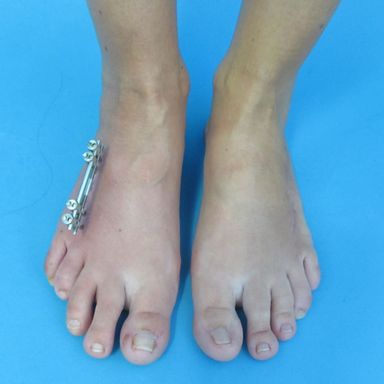
Toe lengthening
Clinical Condition
In a 42-year-old female patient, the 4th toe on both feet had been shortened since birth. The patient complained of increasing pain in the ball of the foot, especially when walking for long periods of time. This was due to the heads of the metatarsals, which were shortened on both sides, were not in line with the neighboring metatarsal heads and thus hindered rolling movement when walking. This pain was the indication for surgical lengthening of the metatarsals of the 4th ray on both sides.

4th beam shortened on both sides

The metatarsal heads of both feet are not in a row
Treatment
Since metatarsals have a diameter of only a few millimeters, a new type of extremely small minifixator was used to lengthen each metatarsal by 25 mm. 1 week after surgery, lengthening started at 1 mm/day to allow new bone to form in the distraction gap. To reduce the time of external fixation, a small platelet was attached to each metatarsal after lengthening was completed, protecting the newly formed regenerate and allowing the patient to increase weight bearing early. To ensure mobility at all times during the treatment, a side-to-side approach was chosen.
Result
After the fixators were removed, normal shoes could be worn again. Physiotherapy and walking exercises increasingly normalized the rolling motion. The pain which had been present prior to treatment had completely disappeared 9 months after the start of treatment.

On the right foot the fixator is still mounted, on the left it has already been replaced by a plate.

Two small plates protect the newly formed metatarsal bones.
More information
Contact
Privacy Policy